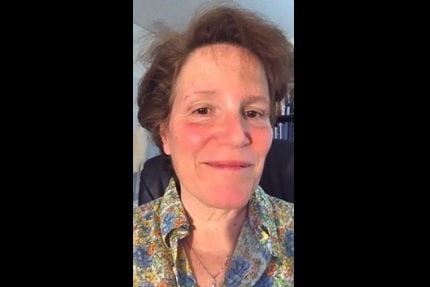At a glance
Meet Catherine Smith, a research microbiologist in the Influenza Division at the Centers for Disease Control and Prevention.

Background
Catherine graduated from Mount Union College (now the University of Mount Union) in 1984 with a degree in Biology. During her senior year, she read a National Geographic article about the CDC Disease Detectives and was hooked; she attended Emory University for her Master of Medical Science (Immunology) degree because of its proximity to CDC. During her master's program she worked in the Physiology lab of Dr. Robert Gunn, studying ion transport across red blood cells. This work led to her thesis project looking at terminal differentiation of cells.
In 1991, she accepted a position at CDC working as a laboratory technician on influenza. In 2014 technology began advancing and next-generation sequencing was generating hundreds of sequences per week. She moved out of the lab to join the Genetic Analysis Team of Influenza Division's Viral Special Pathogens Branch (VSPB) where she has worked since interpreting and reporting influenza genetic sequencing data. In this role, she has been able to travel to many parts of the world to train fellow scientists. For her, the opportunity to train CDC partners in other National Influenza Centers around the world has been one of the best parts of her career at CDC.
What role do you play in fighting flu?
I am a research microbiologist, but that title comes with many hats. Primarily, I interpret the genetic data for seasonal flu viruses. I started out doing genetic analysis of flu viruses across the spectrum, from extraction and sequencing of the viral genome to the post-sequencing analysis and reporting. Now many of these tasks are handled separately, while I focus on the final interpretation and reporting of genetic sequencing data. Due to my years in the Influenza Division, I also serve as a mentor to junior members of our team.
What is the most rewarding part of your work?
I think the most rewarding part of my work is the people. I work with the most amazing group of people who are all dedicated to the same goal. In times of crisis, like the H1N1 pandemic in 2009, the response both within the flu group and parts of the CDC was amazing. Everyone came together, bringing their expertise for this one common goal to fight flu. Everyone in this Division is committed to the goal of protecting the population from flu illness.
What is the most difficult part of your work?
There are only 24 hours in a day. As the workload in the Influenza Division is constant and moves at a rapid pace, it can be difficult to stay abreast of the evolving technologies related to genomic analysis. These technologies can provide more robust interpretations and streamline the workflow, ultimately providing opportunities to advance science.
How serious is flu? What should people know about the risk of flu?
The gravity of a flu infection is underestimated by many. Since flu viruses have always been in circulation during our lifetimes, it is often dismissed as a nuisance. Many people do not realize the number of hospitalizations and deaths that are directly attributed to flu each year. [People should know] that flu vaccine, even if it doesn’t completely prevent illness, helps prevent hospitalization and death.
What would you say to those who are hesitant about getting a flu vaccine?
Since I have had these conversations about the flu vaccine, my first response is to ask, “what is holding you back”? Getting to the root of that person’s hesitancy is important. Having that conversation can get people to act and get their vaccine. Second, I always tell them that getting the vaccine not only protects them but protects the most vulnerable around them – including friends and family.
